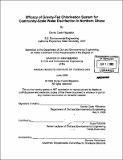Efficacy of gravity-fed chlorination system for community-scale water disinfection in northern Ghana
Author(s)
Fitzpatrick, Daniel Cash
DownloadFull printable version (36.96Mb)
Other Contributors
Massachusetts Institute of Technology. Dept. of Civil and Environmental Engineering.
Advisor
Susan Murcott.
Terms of use
Metadata
Show full item recordAbstract
Although chlorine is one of the lowest cost ways of providing disinfection, currently billions of people lack drinking water that has had this simple treatment. Arch Chemical's Pulsar 1 unit is an innovation in chlorine dosing in that it is a gravity-fed system which does not require electricity while providing relatively accurate dosing. The purpose of this study is to investigate the technical feasibility of the Pulsar 1 unit using high-test hypochlorite (HTH) as a viable chlorination option for community-scale drinking water disinfection in Northern Region, Ghana. In addition, this study compares the Pulsar 1 unit to the household treatment of the Kosim filter plus Aquatabs. The Kosim filter is a pot-shaped Potters for Peace-type ceramic water available in Northern Ghana, while Aquatabs are an alternate chlorine product comprised of sodium dichloroisocyanurate (NaDCC). A pilot study done in Mali in 2005 by EAU Lambda showed the Pulsar's potential to correctly dose a piped water supply with a flow rate of approximately 42 gpm (9.6 m3/hr). The present pilot study has evaluated the Pulsar system in Ghana and Cambridge, MA at flow rates of 18 gpm (4.1 m3/hr) and 9 gpm (2.0 m3/hr), respectively. This was challenging because the Pulsar was designed for swimming pool applications and thus chlorinated at levels higher than appropriate drinking water. As a result, several modifications were made to lower the chlorine concentrations from the Pulsar system into the appropriate drinking water range. Both the Pulsar 1 and Aquatabs systems were found to be technically feasible. The main two advantages of using the Pulsar system over Aquatabs are the vastly reduced operational costs (in $/m3) of disinfection treatment (about 48 times cheaper) and its ability to reach an entire community (compared to just a single household). (cont.) However, these benefits are gained as a tradeoff for increased system complexity and higher capital costs. Overall there is no "single best option", which means site-specific circumstances should dictate the appropriate technology.
Description
Thesis (M. Eng.)--Massachusetts Institute of Technology, Dept. of Civil and Environmental Engineering, 2008. Includes bibliographical references (p. 84-89).
Date issued
2008Department
Massachusetts Institute of Technology. Department of Civil and Environmental EngineeringPublisher
Massachusetts Institute of Technology
Keywords
Civil and Environmental Engineering.